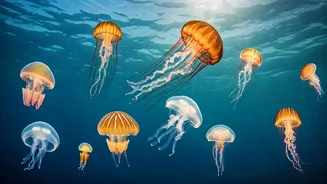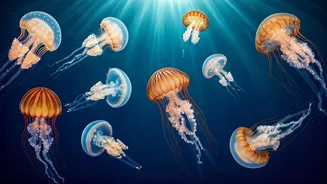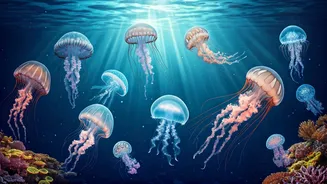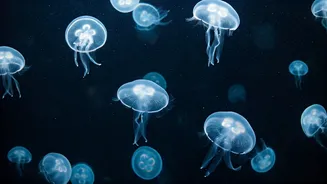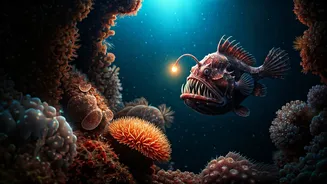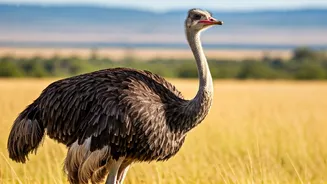Moon Jellyfish
The moon jellyfish, scientifically known as *Aurelia aurita*, is perhaps the most recognizable. This jellyfish is translucent and bell-shaped, often with
a diameter reaching up to 40 centimeters. Found in oceans worldwide, they prefer temperate waters. Moon jellyfish are relatively simple creatures. They feed on plankton, which they capture with their tentacles. These jellyfish are known for their gentle nature and are often seen drifting gracefully in large groups. Their life cycle includes both a polyp stage attached to the seafloor and a free-swimming medusa stage, representing a complete metamorphosis.
Box Jellyfish
Box jellyfish, belonging to the class Cubozoa, are known for their cube-shaped bells, which give them their name. These jellyfish are highly venomous and pose a significant threat. They are primarily found in tropical and subtropical waters. The venom of box jellyfish is potent and can cause severe pain, cardiac arrest, and even death in humans. Their complex visual system, including multiple eyes with lenses and corneas, allows them to navigate and hunt prey efficiently. The venom is delivered via stinging cells called nematocysts located on their tentacles, which are triggered by contact. These jellyfish are active hunters, feeding on fish and other marine organisms.
Lion's Mane
The lion's mane jellyfish (*Cyanea capillata*) is the largest known species of jellyfish. They can grow to massive sizes, with a bell diameter exceeding 2 meters and tentacles extending over 30 meters. This jellyfish is typically found in cold, northern waters of the Atlantic and Pacific Oceans. Their bell is usually reddish-orange, and their tentacles trail behind like a lion's mane, giving them their name. They are voracious predators, capturing prey with their stinging tentacles. Although their sting is painful to humans, it is rarely life-threatening. These jellyfish play a crucial role in marine ecosystems, contributing to food webs and nutrient cycling.
Portuguese Man o' War
The Portuguese man o' war (*Physalia physalis*) is often mistaken for a jellyfish, but it's actually a siphonophore, a colonial organism composed of multiple specialized individual animals. It is easily recognized by its gas-filled bladder, which floats on the surface, allowing the colony to drift with the wind and currents. Found in warm, tropical, and subtropical waters, the man o' war has long, venomous tentacles that can extend up to 30 meters. These tentacles are used to capture prey, primarily small fish. The sting is extremely painful to humans and can cause welts, nausea, and fever. Despite their beauty, these creatures should always be avoided.
Flower Hat
Flower hat jellies (*Olindias formosa*) are visually striking, with a bell that resembles a flower. They are native to the western Pacific Ocean. The bell is often adorned with vibrant colors and patterns. They have numerous tentacles, which are used for both capturing prey and defense. Unlike many other jellyfish, they have a relatively small bell size, usually less than 15 centimeters in diameter. Flower hat jellies are known to have a painful but not life-threatening sting. They are fascinating to observe due to their intricate design and captivating appearance.
Upside-Down Jellyfish
Upside-down jellyfish (*Cassiopea andromeda*) live on the seafloor. They are commonly found in shallow, tropical waters. Their bell is usually pale in color, and they exhibit a unique behavior of resting upside down, with their tentacles facing upwards. They host symbiotic algae called zooxanthellae within their tissues, which provide them with nutrients through photosynthesis. These jellyfish feed primarily on plankton. This inverted orientation allows the algae to receive ample sunlight. Upside-down jellyfish are not strong swimmers, preferring to remain stationary on the seabed, relying on their symbiotic relationship for energy.
Mauve Stinger
The mauve stinger (*Pelagia noctiluca*) is a bioluminescent jellyfish found in warm waters worldwide. It gets its name from its purplish-pink hue. Mauve stingers are known for their frequent blooms, which can result in large aggregations. Their stings are painful, and they can cause skin irritation. They are primarily carnivorous, feeding on small fish and other jellyfish. The bioluminescence is a defense mechanism and is also used to attract prey. These jellyfish play an important role in the marine ecosystem, contributing to food chains. They are an example of the ocean's beauty and complexity.
Comb Jellies
Comb jellies, or ctenophores, are not true jellyfish, but they are often grouped with them due to their similar gelatinous body plans. They lack stinging cells, but use sticky cells called colloblasts to capture prey. Comb jellies are found in all oceans and come in various shapes and sizes. They are known for their bioluminescence and the iridescent display of their cilia, which are used for movement. These cilia beat in coordinated rows, creating a rainbow-like effect. Comb jellies are important predators and play a role in the marine food web. They showcase another level of beauty that the ocean has to offer.
Crystal Jelly
Crystal jellies (*Aequorea victoria*) are known for their bioluminescent properties, specifically producing green fluorescent protein (GFP). This protein has been used extensively in scientific research. They are found in the Pacific Ocean, primarily along the North American coast. They are generally transparent. They feed on small plankton and other invertebrates. The luminescence is thought to be used for defense and possibly for attracting prey. The study of crystal jellies has significantly contributed to our understanding of cellular processes. Their transparency allows for unique study opportunities.
Sea Wasp
Sea wasps, or Chiropsalmus quadrumanus, are a type of box jellyfish. They are found in tropical waters, especially in the Indo-Pacific region. These jellies are known for their cube-shaped bells and potent venom, which can be deadly to humans. Their stings are excruciating, causing intense pain, and may result in cardiac arrest. Sea wasps have multiple eyes, giving them good vision for hunting. They primarily feed on small fish and invertebrates. It is important to avoid contact with these dangerous jellyfish. Their presence serves as a reminder of the hazards that can be found in the ocean.
